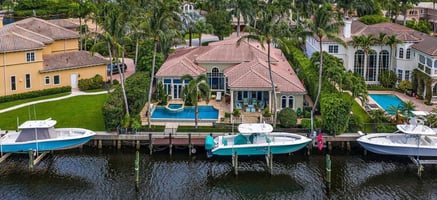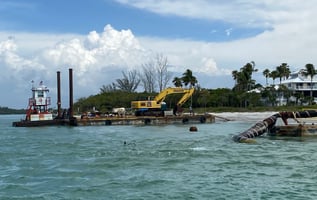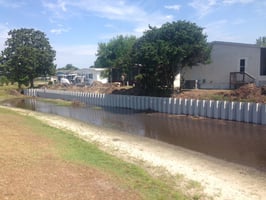A boat lift is designed to secure a boat over the water, either at a private dock or in a marina.
...

Marine-grade lumber
is a type of wood designed to withstand the humid, salty air of the ocean and its inevitable bumps, bruises, and scrapes—many different types of lumber qualify as marine grade. The primary difference between marine-grade boards and how they're treated before being sold. The different types are used for a specific purpose in boat construction or refitting, but each has pros and cons. Here is an overview of some of the most common types:
Solid Marine Grade Lumber
Solid marine lumber comes from trees grown specifically for building boats. The trees are planted in growing areas near lakes, rivers, or oceans with plenty of water to increase the lumber's durability. Some trees are even placed in designed ponds to increase their salt content. The lumber is milled using a process that involves adding a fungicide, preservative, and either copper or zinc to the wood. This process ensures the wood's longevity. While solid marine-grade lumber costs a bit more than other types of marine-grade lumber, it is a good option for those who want to use one type of wood for an entire boat project.
Marine Grade Particle Board (MGPB)
Marine-grade particle board (MGPB) is composite wood. It combines wood pulp, resin, and other materials pressed together, laminated with wood veneer on both sides. It's not a valid form of marine-grade lumber. Because it has a heavy coat of resin, it is treated like one. (MGPB) The most affordable marine-grade lumber was available, making it a good option for DIY projects where cost is a priority. However, it is considered a lower-grade, lower-quality option compared to other types of marine-grade lumber, particularly regarding strength and durability. Because it's manufactured, it can be more challenging to work with than traditional boards.
Marine Grade Vinyl Coated Lumber (VGML)
VGML is essentially the same as MGPB (above). That is, it's also a form of composite wood made chiefly of wood pulp and resin. But MGPB is coated with vinyl instead of a thick resin layer. The vinyl coating helps the wood expand and contract in different temperatures, making it more durable than MGPB. VGML is a good option for DIY projects of any size or scale. It is also the least expensive type of marine-grade lumber.
Marine Grade Plywood (VGPL)
VGPL is what it sounds like—a type of marine-grade plywood. It's made by gluing several layers of wood together, usually with phenolic resins. (VGPL) is used for structural components on boats, such as decks or bulkheads. It can also be used for decorative applications like paneling or finish on the interior of a house. VGPL is extremely strong, making it an excellent choice for anything that will see a lot of wear, such as a deck or walkway. It's also a good option for projects requiring precise measurements. Each sheet is consistent and can be cut to exact measurements using a saw. One drawback of VGPL is that it's more expensive than other types of marine-grade lumber, making it more challenging to use in a budget-friendly project.
Merbau and Bahru
Merbau and Bahru are tropical hardwoods that hail from Southeast Asia and Malaysia. They are prized for their durability and resistance to the elements, making them great for boatbuilding. Merbau is mainly used for decking, while Bahru is often seen as a boat's hull material. Both are incredibly durable and can last for decades, even when exposed to salt and water. They're also easy to work with and can be stained or painted to suit almost any design. The only downside is that they can be more expensive than other types of marine-grade lumber.
Bamboo
Bamboo is known for its strength and flexibility, making it an excellent choice for boatbuilding. It's also a sustainable option since bamboo is a renewable resource. While bamboo is technically a type of grass, it's a popular choice for marine-grade lumber due to its resistance to rot and ability to withstand constant moisture. Like most other hardwoods, bamboo can be stained or painted to suit a variety of aesthetics. The one downside to bamboo is its cost. It typically carries a higher price tag than other types of marine-grade lumber. Other Types of Marine Grade Wood There are many types of marine grade wood equally as durable and resilient as the lumber listed above. These include mahogany, teak, cedar, pine, oak, cypress, spruce, and fir. The only difference between these types of wood and the ones mentioned above is the cost. Generally, the more exotic the wood, the more expensive it is due to the lumber in question coming from a different part of the world.
The Takeaway
While all the above types of lumber are great options for boatbuilding, they can also be helpful for other types of construction, such as building walkways or decks. The only thing to keep in mind is how each type is treated. Once the chemical preservatives are applied, they cannot be removed from the lumber. So, for example, if you use a piece of marine-grade lumber indoors, it will retain its scent and may transfer to your indoor furniture and belongings over time. If you're looking for durable, long-lasting wood for your next project, marine-grade lumber is worth considering. Various kinds of wood are specifically designed to withstand constant exposure to the elements, including saltwater, sun, and extreme temperatures. While the different types of lumber can vary in price and uses, they're all excellent options for those who want their project to last a long time.
For more information or to schedule a free estimate, contact the professionals at Precision Marine Construction at 941.924.6044 for any questions or concerns regarding your marine needs.

A boat lift is designed to secure a boat over the water, either at a private dock or in a marina.
...

Billions of cubic yards of material are removed from sites around the globe to keep big ships and...

Seawalls protect coastal property from destructive water and waves, preventing erosion and the loss...
Blog comments